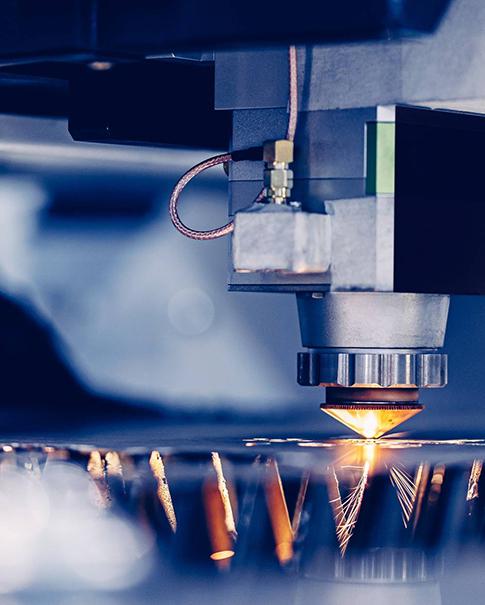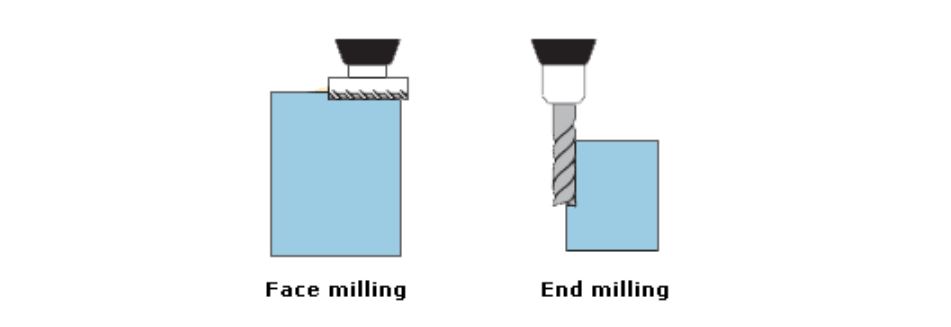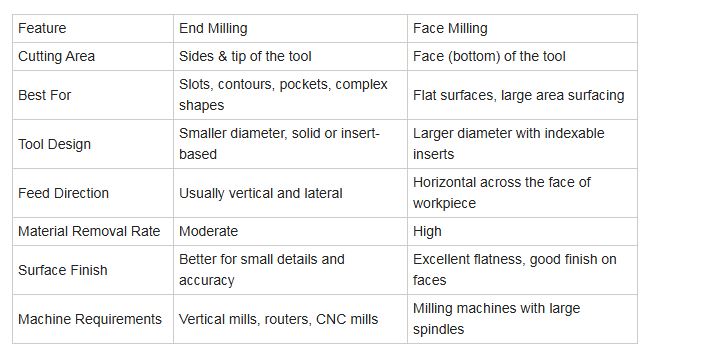
CNC加工の世界では、フライス加工は主要な工程ですが、すべてのフライス加工が同じというわけではありません。エンドミル加工とフェイスミル加工は、広く使用されている2つの加工方法です。それぞれ異なる工具設計、切削形状、そして異なる種類の加工に適しています。どちらもロータリーカッターを用いて金属を加工しますが、切削方法、切削箇所、切削対象が異なります。
このブログでは、エンドミルとフェイスミルの違いを詳しく説明し、性能を比較することで、次のプロジェクトでどちらを選ぶべきかを決めるお手伝いをします。機械工、エンジニア、あるいは精密CNCサービスを探している方にとって、このガイドは必要な情報を明確に提供します。

エンドミル加工は、切削工具を材料に垂直に差し込み、カッターの側面と先端を使って材料を削り取る加工方法です。工具は通常エンドミルで、プランジ、輪郭加工、溝加工、ポケット加工、さらには穴あけ加工も可能なため、非常に汎用性があります。
エンドミルはドリルビットに似ていますが、大きく異なります。エンドミルは側面と先端に溝が刻まれており、垂直方向だけでなく、X、Y、Z軸に沿って水平方向や横方向への切削も可能です。垂直フライス盤やCNCルーターで、以下のような加工に使用されます。
● エッジのプロファイリング
● ポケット状の空洞
● 彫刻
● スロッティング
● 輪郭仕上げ
エンドミルは何に使われるのでしょうか?カスタムパーツ、複雑な形状、金型フィーチャ、試作品、さらには鋳造後の改良など、精度が求められるほぼすべての用途に使われます。
エンドミルには様々な種類があり、それぞれ特定の材料や加工ニーズに合わせて設計されています。例えば:
● スクエアエンドミル: 平らな端面を持ち、きれいなエッジ、平底スロット、ポケット加工の作成によく使用されます。
● ボールノーズエンドミル: 3D 輪郭面用。
● コーナーラジアスエンドミル:先端のエッジが丸くなっており、特に高応力の切削時に耐久性が向上し、工具の摩耗が軽減されます。
● 荒削りエンドミル: 鋸歯状またはローレット状の溝を備えた設計で、荒削りの初期段階で大量の材料を強力に素早く除去します。
アルミニウムなどの非鉄金属を扱う場合は、研磨されたフルート、高いすくい角、および切削片を効率的に排出するためのより少ないフルート数 (2 ~ 3) を特徴とするアルミニウム用のエンド ミルが必要になります。
正面フライス加工は、工具の側面ではなく、面、つまり底面で切削する加工方法です。主に、大型のワークピースに平面(フェース)を加工したり、材料を素早く除去したりするために使用されます。
使用される工具はフェイスミルと呼ばれ、通常は大径の本体に複数の刃先交換式インサートがセットされています。水平に取り付けられ、表面を浅く削ります。
フェイスミル加工は次のような場合に最適です。
● 完全に平らな表面を作成する
● 金属ブロックを四角に切る
● 大量の材料を除去する
● さらなる加工のための材料の準備
実際の比較を見てみましょう。ツールの形状以外に、何が違うのでしょうか?

ポケット穴付きのカスタムブラケットを製作する場合は、エンドミルが最適です。しかし、平らな鋼板を加工して後工程の準備を整える場合は、フェイスミルが最適です。
深いキャビティ、急角度、または複雑な 3D プロファイルを持つ部品の場合、5 軸 CNC 加工により、エンド ミルが複数の方向からワークピースにアプローチできるようになり、新たな可能性が開かれます。その仕組みの詳細については、こちらをご覧ください。
エンドミルとフェースミルのどちらを選択するかは、多くの場合、ツールのサイズ、マシンの馬力、および部品の形状によって決まります。
● フェイスミルは一般的に大径工具であるため、より剛性の高いスピンドルと十分なトルクが必要です。
● エンドミル、特に小径のエンドミルは柔軟性と精度に優れ、小型の機械や複雑な作業に最適です。
ヒント:狭い内角や3D形状を加工するには、エンドミルが必要です。フェイスミルでは複雑な形状を加工できません。
どちらのツールも、鋼、アルミニウム、銅、ステンレス、チタンなど、さまざまな材料で使用できますが、カッターの形状が重要です。
● アルミニウムの場合、急角度のすくい角を持つ、高ねじれの研磨エンドミルとフェースミルを使用します。
● 鋼の場合、コーティングされた超硬工具と最適化されたチップブレーカーを選択してください。
● ステンレス鋼の場合、加工硬化を避けるためには工具の剛性とクーラントの流れが重要です。
工具選びの手間をかけずに、精密な部品加工をお考えですか?当社のCNCフライス加工サービスは、適切な工具を用いて高精度な加工を実現し、常に完璧な部品をお届けします。今すぐお見積もりをご依頼ください。
生産コストの観点から:
● フェースフライス加工は、より効率的な材料除去を実現します。高い材料除去率により、バルク表面仕上げに最適です。
● エンドミル加工は時間がかかりますが、高精度、低仕上げコスト、細かい作業での工具交換回数の削減を実現します。
バッチ生産のサイクルタイムを短縮したいですか?フェースミルを使用してブロックを準備し、エンドミルを使用して精密な機能を追加します。
ツールの寿命はアプリケーションによって大きく異なります。
● エンドミルは硬い材料やコーナーでは摩耗が早くなります。
● フェースミルはインサートの交換により寿命が長くなり、工具全体ではなくインサートのみを交換できます。
どちらも、適切な送り速度、スピンドル速度、およびクーラント戦略の恩恵を受けます。
エンドミルの選択がパフォーマンスにどのような影響を与えるかご興味がありますか?エンドミル加工に関する完全なガイドをお読みになり、よりスマートなツール選定を行ってください。
最終的には、エンドミル加工とフェースミル加工のどちらを選択するかは、プロジェクトの目標によって決まります。
● 平坦性とスピードをお求めですか? フェースミル加工をお選びください。
● 形状と精度が必要ですか? エンドミル加工をお選びください。
多くの場合、フェースミルはブロックを直角にし、エンドミルはフィーチャを仕上げるために併用されます。それぞれの役割を理解することで、加工戦略を最適化し、サイクルタイムを短縮し、工具寿命を延ばすことができます。